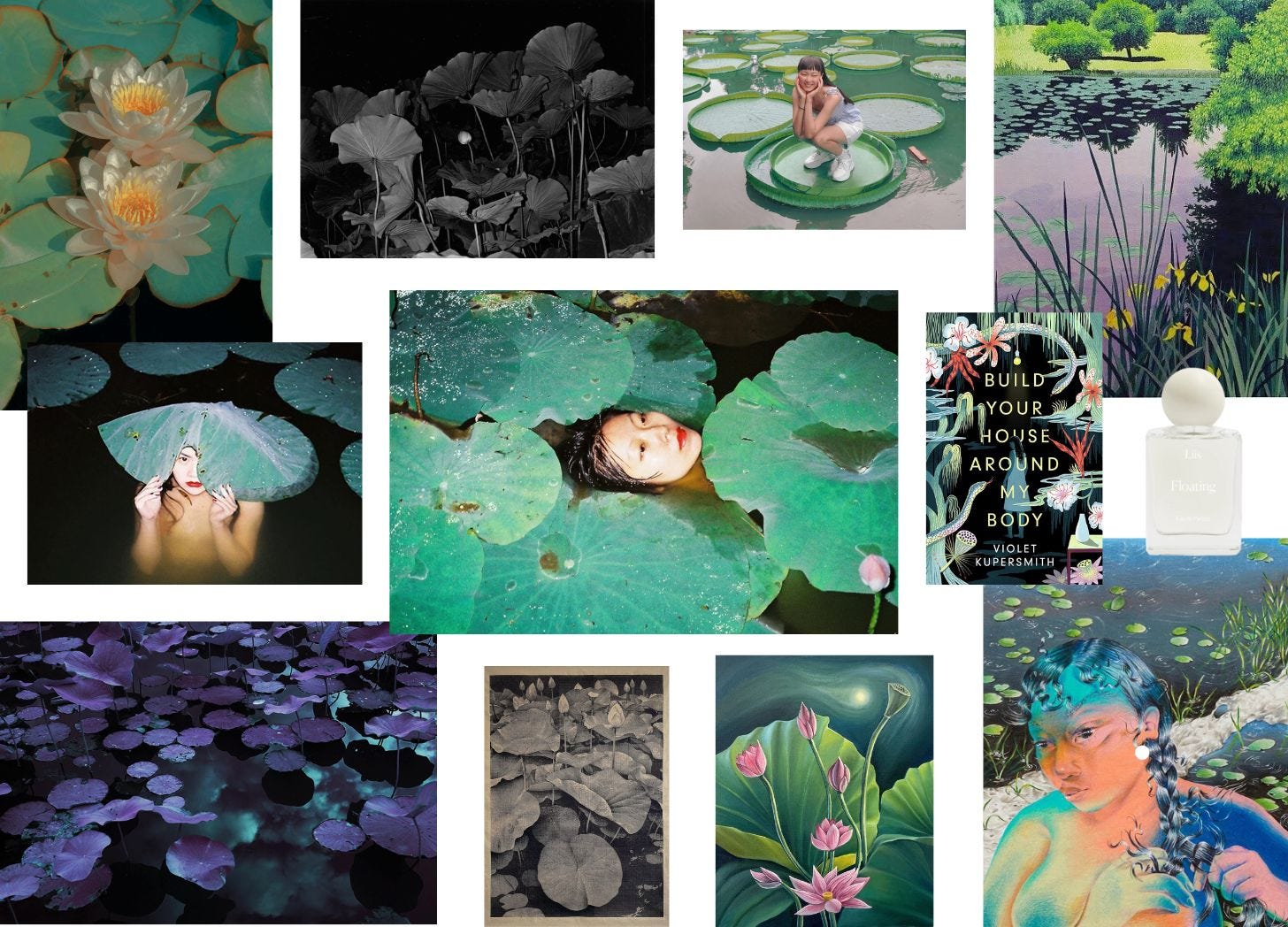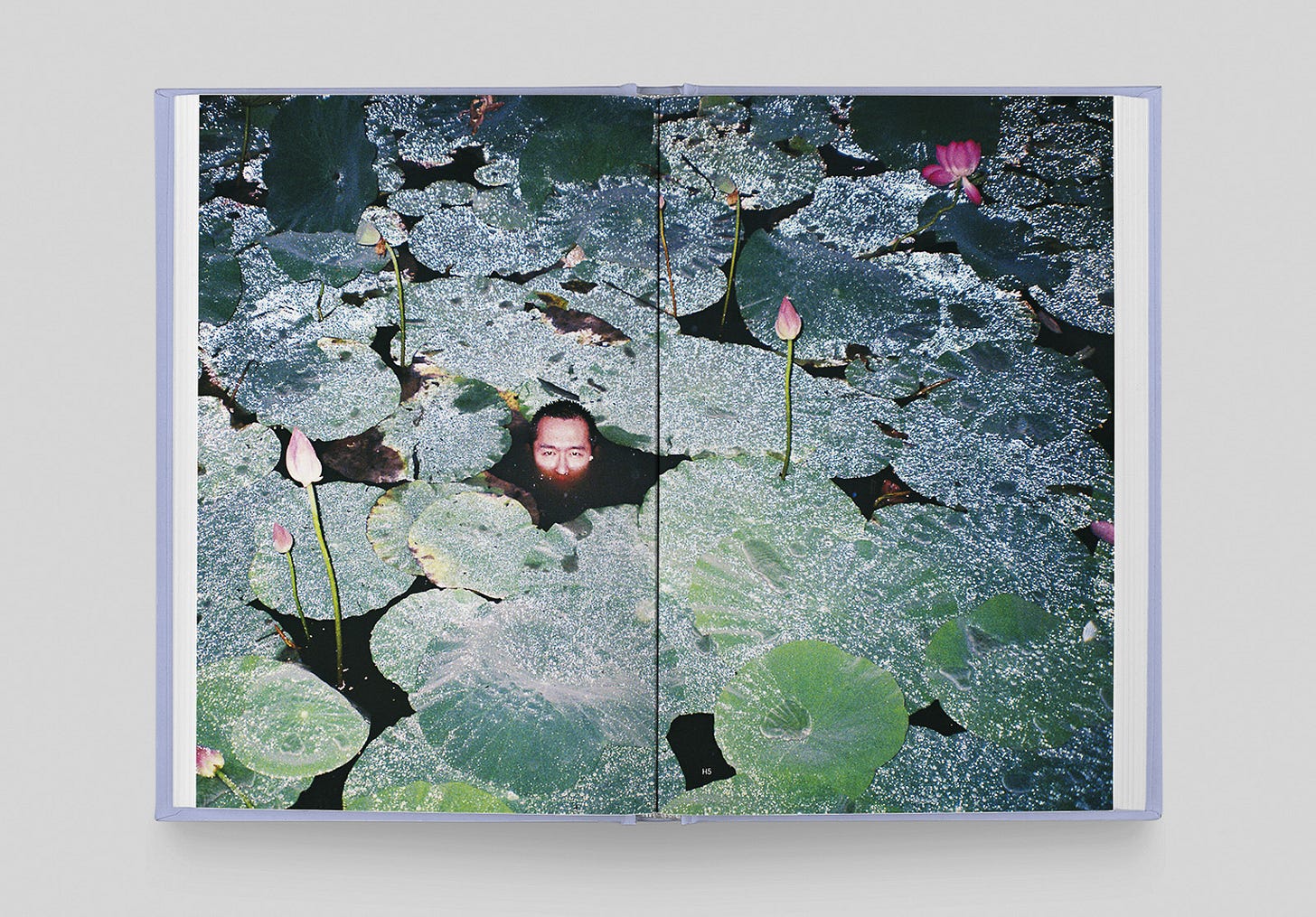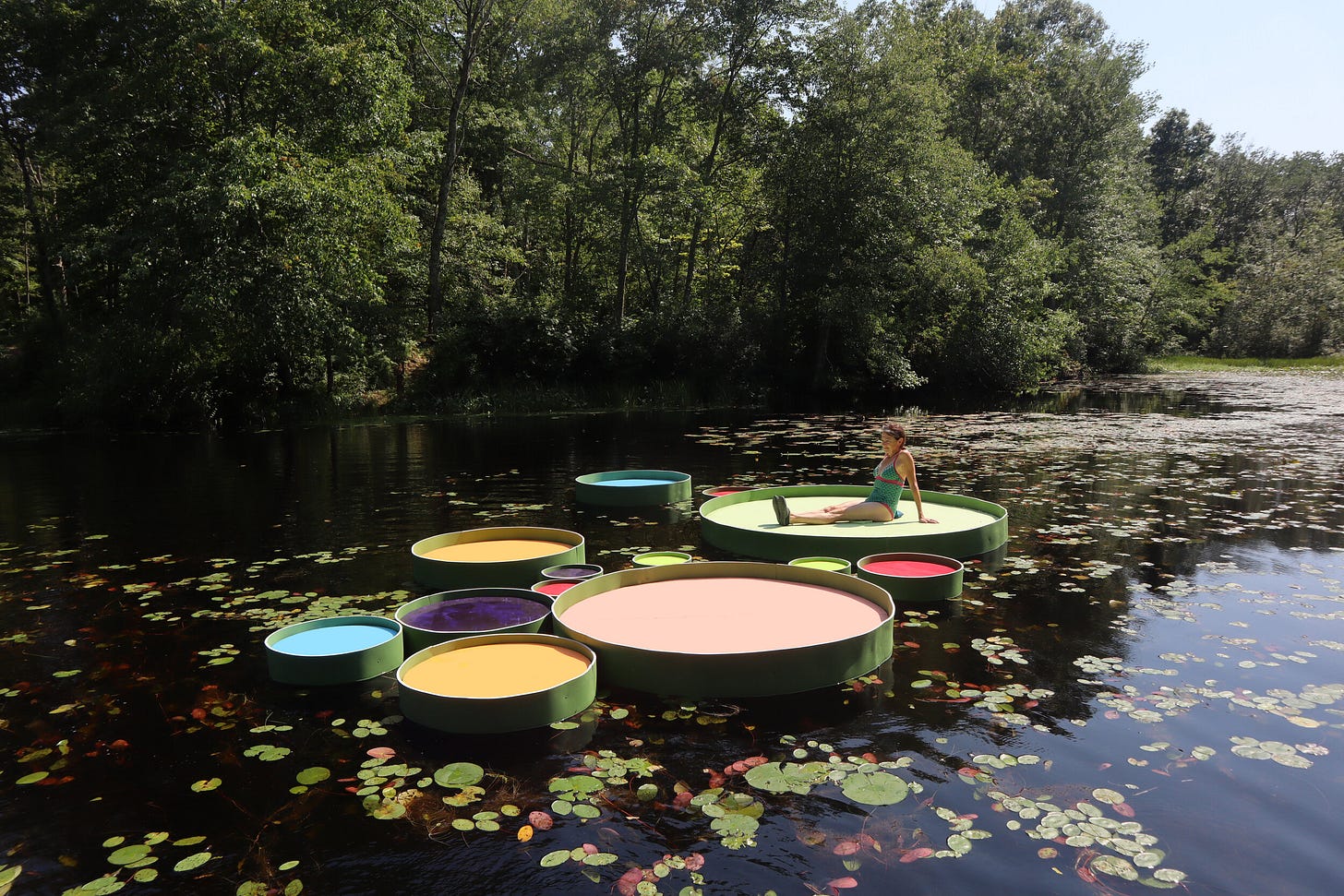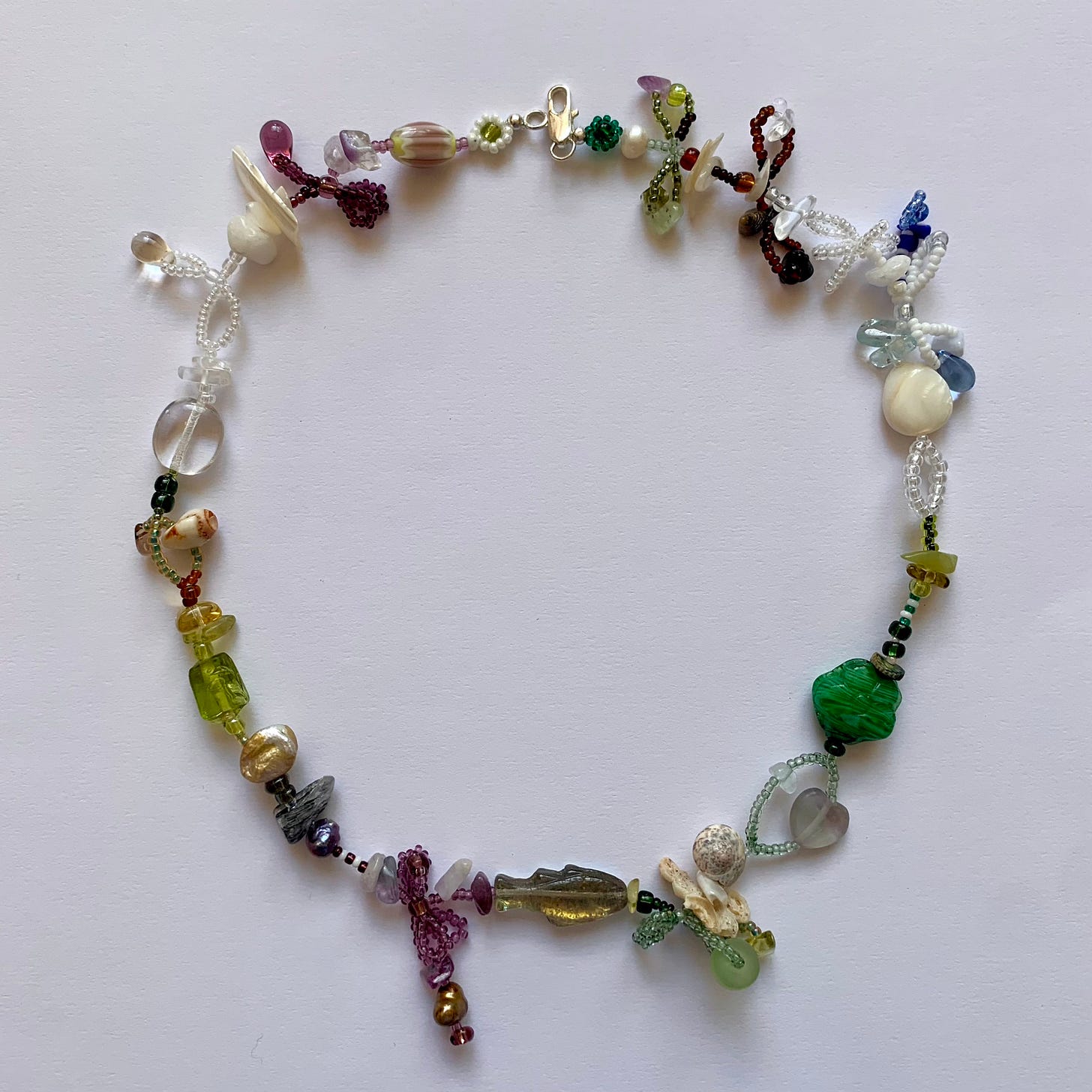The Enchanted Realm of Water Lilies and Lotuses
Wade into the world of floating flowers that thrive in dark waters.
There’s something eerie about the stillness of a pond, where water lilies and lotus flowers glimmer on the surface. It’s a world both enchanting and unsettling, a place where beauty and mystery intertwine. Unlike the idyllic Monet landscapes we often associate with water lilies, these floating realms suggest something lurking under the surface, a threshold to the unknown.
In folklore, shallow waters are often linked with spirits and supernatural beings: Scottish legends tell of Ashrays, translucent creatures that dissolve into puddles if touched by sunlight. Then there are the Naiads, water nymphs said to lure men into watery graves. In The Man Who Could Move Clouds, author Ingrid Contreras Rojas describes one such spirit in Colombia: “Far away, in the jungle, Nono happened upon a clearing where a lagoon spirit appeared. It took the form of a beautiful woman, bathing naked and washing her hair. The waterline swallowed her hips. When Nono saw her, he stopped in his tracks. He knew very well what she was. She wasn’t the most beautiful woman he had ever seen, but a supernatural beast.”
What is it about water lilies and lotuses that pull at the edges of our imagination? Perhaps it’s how these delicate blooms rise from ominous origins, their beauty intensified by the darkness from which they emerge. The American lotus, for example, with its soft, buttery-yellow petals, ascends gracefully above broad pads that shimmer with droplets of rain like tiny jewels. Perched on slender stems, their petals spiral open to reveal golden centers, intricately laced with white-tipped threads. No wonder these beguiling plants have long inspired artists and storytellers—a theme we’ll explore in this edition of Arrangements. There’s magic here, but it’s the kind that makes you question whether you should linger too long.
In Xuebing Du’s work, water lilies transform into vessels of light, color and texture. Her photograph bathes the lilies in an ethereal glow, their white petals iridescent, while the yellow stamens, reminiscent of stringy pressed Play Doh, add a whimsical touch.
Issei Suda’s 1975 photo of lotus leaves portrays the strange beauty of nature under his signature sharp flash. The stark light transforms the composition into something almost otherworldly, where the leaves rise like silent sentinels in the darkness.
Lanise Howard’s “Sesen Moon” invites you into a dreamscape where lotus blossoms stretch toward a moonlit sky. Known for her figurative work that often centers Black figures in spaces of possibility and transformation, Howard explores a different kind of narrative here—one that still touches on themes of growth and change, but through the lens of nature.
Ren Hang remains one of my favorite photographers, and it was an honor to include his work in Strange Plants II. In this series, figures emerge from shadowy waters, their faces half-hidden among the glistening lotus leaves, or with a stem gently held between their lips. The images evoke an otherworldly atmosphere, as if pulled from the pages of a dark fairy tale, showcasing Hang's unique ability to blur the line between beauty and discomfort.
In Strange Plants III, I featured the work of French photographer Marilyn Mugot. Her Venus’ Gardens series showcases water lilies bathed in velvety greens, purples and reds. “I use my camera as I use a paintbrush,” Mugot explains, “and I imagine the world, the environment, as a large palette of colors.”
Sasha Gordon’s colored pencil piece depicts a figure with skin in shifting hues of blues and oranges, her braids mirroring the rippling water around her. The image feels like a moment of metamorphosis, as if she’s becoming part of the pond itself. Gordon, a queer Asian-American woman, often explores themes of self-image and identity, and this work reflects her ongoing journey of challenging societal norms and embracing the fluidity of her own existence.
At Shuangxi Park in Taipei, visitors can float on the broad, green discs of Victoria Amazonica, the largest of water lilies. Similarly, The Lily Project, created by Jaemee Studio at I-Park Foundation in Connecticut, draws inspiration from natural lily pads. From afar, the buoyant foam pads blend seamlessly into the pond, their edges camouflaged in green. But up close, they reveal vibrant colors, inviting visitors to become part of the drifting art.
Gordon Mortensen’s “Paramecium Pond” pulls you into a world of quiet beauty, where yellow irises stand in soft focus, and lily pads drift across a glassy pond. What appears to be a painting is actually a woodcut—a process that unfolds slowly, sometimes taking years to carve a single moment.
Ron Weis’ artwork captures the quiet strength of lotus plants, their large leaves unfurling like shields over still water, with buds poised to bloom. Rendered in monochromatic tones, the piece invites you to dwell on the details—the texture of each leaf, the interplay of light and shadow.
Build Your House Around My Body by Violet Kupersmith is a haunting exploration of Vietnam’s landscapes and history, where past and present collide unexpectedly. At its center is Winnie, a Vietnamese-American woman whose mysterious disappearance in Saigon unravels a web of ghostly secrets. One particularly chilling thread involves a paranormal dripping sound, leading to a moment where “Winnie could smell a whiff of something foul and clammy: cold, deep water, silt, the clinging, green overtone of algae.”
Floating by Liis is one of my favorite perfumes, embodying the sensation of water lilies drifting in a pond. Notes of ripe peach and bergamot hover above wild orchid and sequoia wood, evoking a world where time and obligation dissolve.
If you’re like me and already thinking about Halloween, check out Lela Christiana’s idea for a Swamp Hag costume, which includes a green ruched top that looks like aquatic plants clinging to the body, and a sheer dress that glistens with crystals, as if dripping with water droplets. Her Pinterest has even more ideas.
Whether channeling the Creature from the Black Lagoon for Halloween or embracing the vibe year-round, Yona Kohen’s Swamp Necklace is the perfect piece. Crafted from glass beads, shells, pearls and natural stones, this necklace lies at the intersection of sculptural and organic, meant to evoke the mysterious beauty of hidden, floating worlds.
If vintage is more your vibe, try these silver hoops featuring lotus flowers. For more of my vintage finds, check out the strange plant-inspired collection I curated for
.
If you enjoyed this post, here are a few ways you can support my work:
Step into the world of the Passionflower, where striking beauty and symbolism intertwine.
Take a surreal, plant-filled journey into Quetzalcoatl’s Nest.
Tap the ♥️ button at the bottom of this post.











Ponds are magical. I absolutely loved this read.
i spy sasha gordon